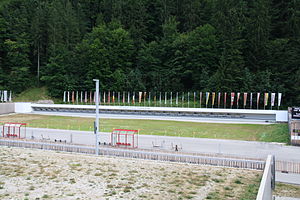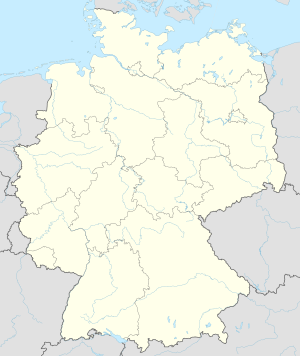Chiemgau Arena
| Chiemgau-Arena Ruhpolding | ||
|---|---|---|
|
|
||
 |
||
| Data | ||
| place |
|
|
| owner | Ruhpolding municipality | |
| opening | 1964 | |
| modification | 2010 | |
| Spectator seats | Stadium 13,000, distance 10,000 |
|
| Events | ||
Coordinates: 47 ° 42 ′ 52 ″ N , 12 ° 38 ′ 51 ″ E The Chiemgau-Arena (formerly: Stadion am Zirmberg ) is a training and competition venue for biathlon and Nordic disciplines in Ruhpolding, Upper Bavaria.
history
The first national and international competitions were held at the "Maurerhals" from 1970. From 1972 Hans Pichler and Theo Merkel drove the planning for a system on the Zirmberg . Construction began in 1977. Many active athletes and young athletes such as Herbert Fritzenwenger , Walter Pichler and Peter Angerer helped set up the facility. Just two years later, the first world championships were held in the new stadium on the Zirmberg .
In the following years, the facility was continuously expanded to meet the requirements of associations and athletes for a competition and training facility. Another world championship was held in 1985, with a total of 30,000 spectators following the competitions and the fight for third place in the West German relay with Herbert Fritzenwenger, Walter Pichler, Peter Angerer and Fritz Fischer .
The stadium was extensively renovated and a new functional building was built for the 1996 biathlon world championships . A total of 50,000 visitors came to the competitions.
In 2005, the ski jumping facility was modernized at Zirmberg so since then the World Cup of Nordic Combined can take place here. The facility was named after its location in Chiemgau : Chiemgau-Arena . Since the summer of 2006, the course has had the IBU A status as well as the FIS homologation of the jumps and cross-country trails for World Cups and World Championships, making the arena one of the most modern winter sports arenas in the world.
The Ricco-Groß-Haus with treadmill, weight room and an area for physiotherapy was inaugurated in 2009.
In 2010, the stadium was converted for the 2012 Biathlon World Championships in order to meet all the requirements for this major event. The old functional building and the container building from 1996 were completely demolished and a multi-storey functional building was erected. The facilities include rooms for doping control, sanitary and common rooms for the athletes, a press center, a catering area and additional technical rooms. The capacity of the grandstands was increased to up to 13,000 spectators after the renovation. In order to be able to offer better working conditions for photographers at the events, the shooting range was moved three places to the east. The competition tracks were widened and expanded.
Data
overview
The Chiemgau-Arena is a facility of the community of Ruhpolding, the sponsorship is supported by the Federal Ministry of the Interior and the Bavarian Ministry of Culture as well as by the forestry company Bayerische Staatsforsten, which is the owner of the property.
The facility is an important Olympic base in Germany for Nordic disciplines and biathlon . The training and competition center includes jump facilities, cross-country trails, a shooting range and asphalt roller ski runs .
location
The Chiemgau-Arena is located directly on the B 305 , south of the community of Ruhpolding in the direction of Reit im Winkl . The stadium is located in a valley, nestled between the Unterberg in the north and the Zirmberg in the south, at around 700 meters above sea level .
Furnishing
Since the renovation for the Biathlon World Championships in 2012 , the stadium has, in addition to the shooting range, running tracks and jumps, an extensive infrastructure for training and competitions. In front of the main building is the grandstand, which with its grandstand and two additional variable blocks can accommodate up to 14,000 spectators. The area behind the main building is used as a training area for roller skis in summer and is available to the media during competitions and is also used as a test and warm-up run. With standing room on the tracks, the stadium has a total capacity of around 30,000 visitors.
The Ricco-Groß-Haus , named after the former German biathlete Ricco Groß , has the largest medical treadmill in the world, a weight room, sanitary facilities and spacious areas for physiotherapy.
A large part of the cross-country skiing trails in winter can also be used as paved roller-ski trails in summer.
Cross-country trails
The maximum gradient of the cross-country route is 20 percent, the highest point is at 749 m above sea level.
The following routes are recognized by the FIS:
- 1.875 km of cross-country skiing
- 2.5 km of cross-country skiing
- 3.3 km of cross-country skiing
- 3.75 km of cross-country skiing
- 5.0 km of cross-country skiing
- 7.5 km of cross-country skiing
- 1.1 km sprint women
- 1.5 km sprint men
Jumps
The arena offers five different jumps for training and competitions:
- Children's hill K 20 m
- School jump K 40 m
- Youth hill K 65 m
- Toni-Plenk-Schanze HS 100 m
- Large Zirmbergschanze HS 128 m
Events
biathlon
Since 1980 races have been held annually in the Chiemgau-Arena as part of the Biathlon World Cup . In addition, the Biathlon World Championships were held in Ruhpolding in 1979 , 1985 , 1996 and 2012 . Other regularly held events include the German Biathlon Championships and races as part of the German Cup. Races as part of the IBU Cup are rarely held in Ruhpolding, most recently during the 2013/14 season . The British Biathlon Association regularly holds its ski championships in the Chiemgau Arena. In addition, many races for young athletes take place in Ruhpolding.
Ski jumping
In 1992, a ski jumping World Cup was held on the Großer Zirmbergschanze . In 2003, Ruhpolding was the station for the men's ski jumping Continental Cup after the jumps in 2001 and 2002 were canceled due to lack of snow. In February 2011 two FIS Cup competitions took place. In March 2014, the women's Continental Cups and the FIS Cups were held here.
Nordic combination
From 2005 to 2007 a competition took place on the hill as part of the Warsteiner Grand Prix Germany in Nordic Combined.
Training center
The Chiemgau-Arena is available as a training center for members of the squad as well as the athletes of the clubs and associations within the DSV . In the summer, the associations of other nations also use the stadium as a training camp in preparation for the competitions in winter. The routes are closed to hobby and recreational athletes.
See also
Individual evidence
- ↑ Kaderathleten ( Memento of the original from February 2, 2016 in the Internet Archive ) Info: The archive link was inserted automatically and has not yet been checked. Please check the original and archive link according to the instructions and then remove this notice. at www.chiemgau-arena.de, accessed on February 9, 2015
- ↑ Chiemgau-Arena on Skisprungschanzen.com
Web links
- www.chiemgau-arena.de Official website


